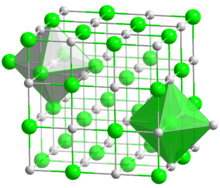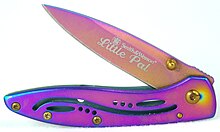Titanium nitride

| |

| |
| Names | |
|---|---|
| IUPAC name
Titanium nitride
| |
| Identifiers | |
3D model (JSmol)
|
|
| ECHA InfoCard | 100.042.819 |
| EC Number |
|
PubChem CID
|
|
CompTox Dashboard (EPA)
|
|
| |
| |
| Properties | |
| TiN | |
| Molar mass | 61.874 g/mol |
| Appearance | Coating of golden color |
| Odor | Odorless |
| Density | 5.22 g/cm3 |
| Melting point | 2,930 °C (5,310 °F; 3,200 K) |
| insoluble | |
| +38×10−6 emu/mol | |
| Thermal conductivity | 19.2 W/(m·°C) |
| Structure | |
| Cubic, cF8 | |
| Fm3m, No. 225 | |
| Octahedral | |
| Related compounds | |
Related coating
|
Titanium aluminum nitride |
Except where otherwise noted, data are given for materials in their standard state (at 25 °C [77 °F], 100 kPa).
| |
Titanium nitride (Template:TitaniumTemplate:Nitrogen) (sometimes known as tinite) is an extremely hard ceramic material, often used as a coating on titanium alloys, steel, carbide, and aluminium components to improve the substrate's surface properties.
Applied as a thin coating, TiN is used to harden and protect cutting and sliding surfaces, for decorative purposes (due to its gold appearance), and as a non-toxic exterior for medical implants. In most applications a coating of less than 5 micrometres (0.00020 in) is applied.
Characteristics
TiN has a Vickers hardness of 2400, a modulus of elasticity of 251 GPa, a thermal expansion coefficient of 9.35×10−6 K−1, and a superconducting transition temperature of 5.6 K.[1][2]
TiN will oxidize at 800 °C in a normal atmosphere. It is chemically stable at 20 °C, according to laboratory tests, but can be slowly attacked by concentrated acid solutions with rising temperatures.[1]
TiN has infrared (IR) reflectivity properties, reflecting in a spectrum similar to elemental gold (Au), which gives it a yellowish color. Depending on the substrate material and surface finish, TiN will have a coefficient of friction ranging from 0.4 to 0.9 against another TiN surface (non-lubricated). The typical TiN formation has a crystal structure of NaCl-type with a roughly 1:1 stoichiometry; TiNx compounds with x ranging from 0.6 to 1.2 are, however, thermodynamically stable.[3] A thin film of TiN was chilled to near absolute zero, converting it into the first known superinsulator, with resistance suddenly increasing by a factor of 100,000.[4]
Uses


A well-known use for TiN coating is for edge retention and corrosion resistance on machine tooling, such as drill bits and milling cutters, often improving their lifetime by a factor of three or more.[5]
Because of TiN's metallic gold color, it is used to coat costume jewelry and automotive trim for decorative purposes. TiN is also widely used as a top-layer coating, usually with nickel (Ni) or chromium (Cr) plated substrates, on consumer plumbing fixtures and door hardware. As a coating it is used in aerospace and military applications and to protect the sliding surfaces of suspension forks of bicycles and motorcycles as well as the shock shafts of radio controlled cars. TiN is non-toxic, meets FDA guidelines and has seen use in medical devices such as scalpel blades and orthopedic bone saw blades where sharpness and edge retention are important.[6] TiN coatings have also been used in implanted prostheses (especially hip replacement implants) and other medical implants.
Though less visible, thin films of TiN are also used in microelectronics, where they serve as a conductive barrier between the active device and the metal contacts used to operate the circuit. The film blocks the diffusion of metal of the conductor into the silicon, but it is conductive enough (30–70 μΩ·cm) to allow a good electrical connection. In this context, TiN is classified as a "barrier metal", even though it is clearly a ceramic from the perspective of chemistry or mechanical behavior. Recent chip design in the 45 nm technology and beyond also makes use of TiN as a metal material for improved transistor performance. In combination with gate dielectrics (e.g. HfSiO) that have a higher permittivity compared to standard SiO2 the gate length can be scaled down with low leakage, higher drive current and the same or better threshold voltage.[7] TiN has also been used in fusion power experiments due to its ability to tightly bond with oxygen molecules.[8]
Due to their high biostability, TiN layers may also be used as electrodes in bioelectronic applications [9] like in intelligent implants or in-vivo biosensors that have to withstand the severe corrosion caused by the body fluid. TiN electrodes have already been applied in the subretinal prosthesis project [10] as well as in biomedical microelectromechanical systems (BioMEMS).[11]
Fabrication

The most common methods of TiN thin film creation are physical vapor deposition (PVD, usually sputter deposition, cathodic arc deposition or electron beam heating) and chemical vapor deposition (CVD).[12] In both methods, pure titanium is sublimed and reacted with nitrogen in a high-energy, vacuum environment. TiN film may also be produced on Ti workpieces by reactive growth (for example, annealing) in a nitrogen atmosphere. PVD is preferred for steel parts because the deposition temperatures exceeds the austenitizing temperature of steel. TiN layers are also sputtered on a variety of higher melting point materials such as stainless steels, titanium and titanium alloys.[13] Its high Young's modulus (values between 450 and 590 GPa have been reported in the literature [14]) means that thick coatings tend to flake away, making them much less durable than thin ones. Titanium nitride coatings can also be deposited by thermal spraying whereas TiN powders are produced by nitridation of titanium with nitrogen or ammonia at 1200 °C.[1]
Bulk ceramic objects can be fabricated by packing powdered metallic titanium into the desired shape, compressing it to the proper density, then igniting it in an atmosphere of pure nitrogen. The heat released by the chemical reaction between the metal and gas is sufficient to sinter the nitride reaction product into a hard, finished item. See powder metallurgy.
Other commercial variants

There are several commercially used variants of TiN that have been developed in the past decade, such as titanium carbon nitride (TiCN), titanium aluminium nitride (TiAlN or AlTiN), and titanium aluminum carbon nitride, which may be used individually or in alternating layers with TiN. These coatings offer similar or superior enhancements in corrosion resistance and hardness, and additional colors ranging from light gray to nearly black, to a dark iridescent bluish-purple depending on the exact process of application. These coatings are becoming common on sporting goods, particularly knives and handguns, where they are used for both cosmetic and functional reasons.
As a constituent in steel making
Titanium nitride is also produced intentionally within some steels by judicious addition of titanium to the alloy. TiN forms at very high temperatures because of its very low enthalpy of formation, and even nucleates directly from the melt in secondary steelmaking. It forms discrete, micrometre-sized cubic particles at grain boundaries and triple points, and prevents grain growth by Ostwald ripening up to very high homologous temperatures. Titanium nitride has the lowest solubility product of any metal nitride or carbide in austenite, a useful attribute in microalloyed steel formulas.
Natural occurrence
Osbornite is a very rare natural form of titanium nitride, found almost exclusively in meteorites.[15][16]
References
- ^ a b c Hugh O. Pierson (1996). Handbook of refractory carbides and nitrides: properties, characteristics, processing, and applications. William Andrew. p. 193. ISBN 0-8155-1392-5.
- ^ Stone, D. S.; K. B. Yoder; W. D. Sproul (1991). "Hardness and elastic modulus of TiN based on continuous indentation technique and new correlation". Journal of Vacuum Science and Technology A. 9 (4): 2543–2547. doi:10.1116/1.577270.
- ^ Toth, L.E. (1971). Transition Metal Carbides and Nitrides. New York: Academic Press. ISBN 0-12-695950-1.
- ^ "Newly discovered 'superinsulators' promise to transform materials research, electronics design". PhysOrg.com. 2008-04-07.
- ^ "Titanium Nitride (TiN) Coating". Surface Solutions Inc. June 2014.
- ^ "Products". IonFusion Surgical. Retrieved 2009-06-25.
- ^ Dziura, Thaddeus G.; Benjamin Bunday; Casey Smith; Muhammad M. Hussain; Rusty Harris; Xiafang Zhang; Jimmy M. Price (2008). "Measurement of high-k and metal film thickness on FinFET sidewalls using scatterometry". Proceedings of SPIE. 6922 (2). International Society for Optical Engineering: 69220V. doi:10.1117/12.773593.
- ^ "Vacuum Chamber Gets titanium Nitride Coating, New Window as Tests Near". LPP Fusion.
- ^ M. Birkholz; K.-E. Ehwald; D. Wolansky; I. Costina; C. Baristyran-Kaynak; M. Fröhlich; H. Beyer; A. Kapp; F. Lisdat (2010). "Corrosion-resistant metal layers from a CMOS process for bioelectronic applications" (PDF). Surf. Coat. Technol. 204 (12–13): 2055–2059. doi:10.1016/j.surfcoat.2009.09.075.
- ^ H. Hämmerle; K. Kobuch; K. Kohler; W. Nisch; H. Sachs; M. Stelzle (2002). "Biostability of micro-photodiode arrays for subretinal implantation". Biomat. 23 (3): 797–804. doi:10.1016/S0142-9612(01)00185-5.
- ^ M. Birkholz; K.-E. Ehwald; P. Kulse; J. Drews; M. Fröhlich; U. Haak; M. Kaynak; E. Matthus; K. Schulz; D. Wolansky (2011). "Ultrathin TiN membranes as a technology platform for CMOS-integrated MEMS and BioMEMS devices". Adv. Func. Mat. 21 (9): 1652–1654. doi:10.1002/adfm.201002062.
- ^ "Wear Coatings for Industrial Products". Diffusion Alloys Limited. Retrieved 2013-06-14.
- ^ "Coatings". Coating Services Group, LLC. Retrieved 2009-06-25.
- ^ G. Abadias (2008). "Stress and preferred orientation in nitride based PVD coatings". Surf. Coat. Technol. 202 (11): 2223–2235. doi:10.1016/j.surfcoat.2007.08.029.
- ^ "Osbornite". Mindat.org. Hudson Institute of Mineralogy. Retrieved Feb 29, 2016.
- ^ "Osbornite Mineral Data". Mineralogy Database. David Barthelmy. Sep 5, 2012. Retrieved Oct 6, 2015.
